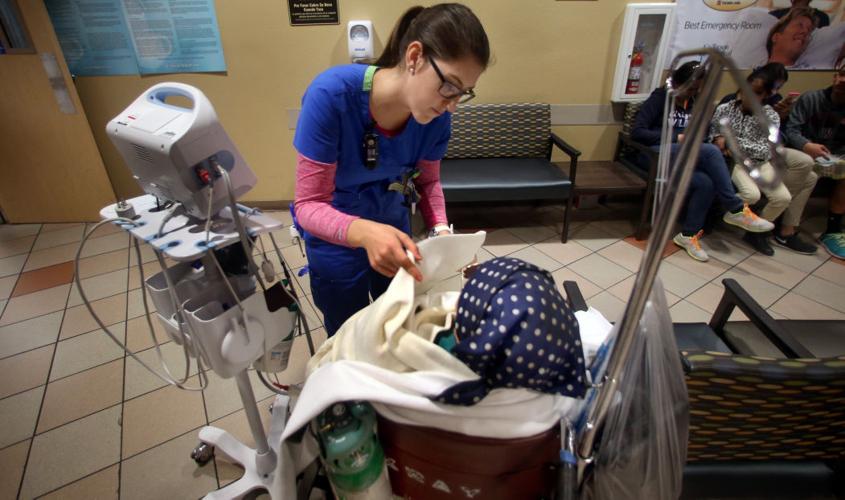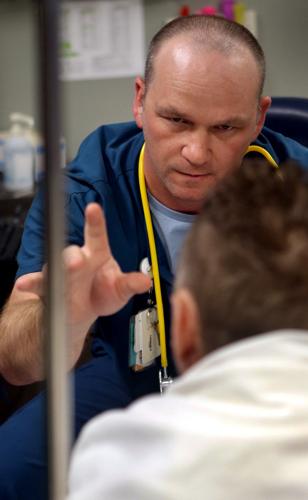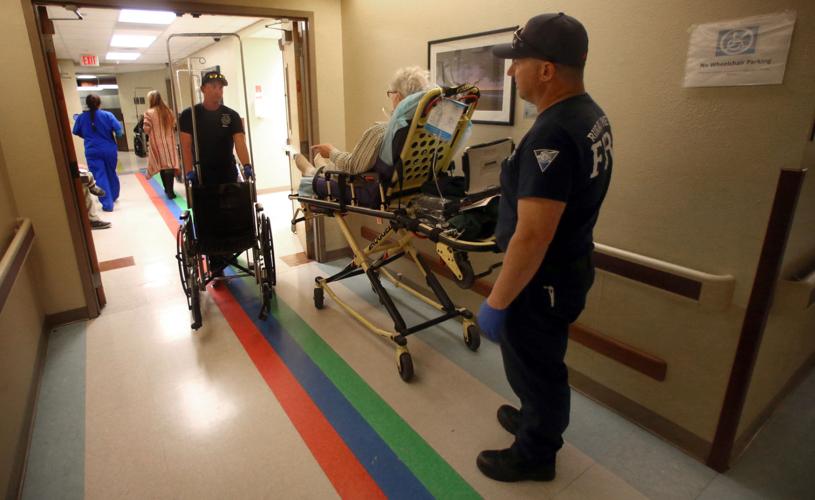One night in March, during a 48-hour period when a record 573 patients sought help at Tucson’s busiest emergency department, a young man with severe pain in his leg lay down on the waiting-room floor.
Frustrated after hours without being seen, the man, whose age is listed in state reports as under 32, called his mother. She called Tucson Medical Center and asked for help. But he continued to wait, moving into a wheelchair and then back onto the floor, trying to ease his discomfort. At one point a security guard brought him a blanket. After seven hours, he went home without being treated.
Five days later, he was dead.
There’s no way to know whether the man’s life would have been spared if he’d been seen that night. But the incident prompted TMC, which has the state’s third-busiest emergency department, to make several changes to its emergency-room processes and procedures.
“We want to be better prepared. We don’t want this ever to happen to us again,” said Dr. Rick Anderson, who is Tucson Medical Center’s chief medical officer. “We cannot let them sit out there for five or six hours without someone checking or rechecking their vitals.”
Finding solutions to emergency-room crowding is a growing challenge in Tucson and nationwide. There had been an expectation that, with the Affordable Care Act and Medicaid expansion, more Americans would have health insurance — and therefore preventive care that would make them less likely to use emergency departments.
But emergency-room visits have gone up, not down. At TMC, emergency-department volume in the first quarter of 2015 was up almost 12 percent over the year before.
In a recent poll of American College of Emergency Physicians members, 78 percent of doctors who responded reported an increase in emergency department volume since the implementation of the Affordable Care Act.
Newly insured people have to learn to navigate the medical system, said Kip Piper, a Washington D.C.-based health-care consultant and a former senior adviser with the U.S. Centers for Medicare & Medicaid Services. People who had been uninsured or underinsured are often accustomed to seeking care at the emergency room, he said.
“We are creatures of habit — we do what we know,” Piper said. “Being covered is necessary, but not sufficient for getting the right care at the right time. It does not guarantee you will get into a doctor.”
People on Medicaid — Arizona’s program for very-low-income residents is called the Arizona Health Care Cost Containment System, or AHCCCS — are using emergency rooms at a higher rate than those with insurance, the emergency physicians group says. Since January 2014, Arizona’s Medicaid population has spiked 41 percent and is now at 1.8 million people.
Many primary-care doctors won’t accept Medicaid because of low reimbursement rates, the American College of Emergency Physicians says.
Also, people on Medicaid often work minimum-wage jobs that do not afford them the ability to leave for a doctor’s appointment during the day, and they lack sufficient transportation or time to seek preventive care, Piper said. And unlike many people with private insurance, those on AHCCCS don’t pay extra out-of-pocket costs for emergency services.
“Depending on who you believe, there is a primary-care-physician shortage because of all the additional patients coming into health insurance due to the Affordable Care Act,” said Anderson, who in addition to being a hospital administrator does shifts as an emergency-department clinician.
“I’ve found people are no longer afraid to come to the ED because of the cost. They can come and get treated. A lot of times it’s that attitude — ‘I want access now.’”
Left Without Being Seen
One change at TMC is focusing on emergency-department patients known was “LWOBS,” which stands for ‘left without being seen.’ No hospital emergency department wants LWOBS, but on busy nights when triage nurses are doing their best to prioritize the sickest patients, it happens, as it did on March 17 when the man lay on the floor in pain.
State investigators with the Arizona Department of Health Services, which licenses the hospital, found two other patients who had left TMC by the time they were called for treatment or assessment that night.
Both were pregnant. One woman with vaginal bleeding, cramping, severe pain and abnormal vital signs was called back for an ultrasound more than three hours after she’d been triaged. The other, also with bleeding and pain, was left to sit in the waiting room for nearly seven hours before she was called back for further assessment.
TMC agreed to pay the state a fine of $1,000 for failing to ensure the three patients received emergency services. The state investigation came about because of a complaint, records show.
The man with the sore leg, which was also red, told hospital officials his pain level was 10 out of 10. His mother told investigators she called the hospital’s emergency department at least four times to let them know her son’s pain was worse.
But the state report report indicates hospital officials told her the department was busy, that sicker patients needed to be seen first, and that he was being checked on. After waiting more than seven hours, he gave up and went home. About 11 hours later, he went to another hospital, was admitted to the intensive care unit with sepsis, and died March 23, the state report says.
The hospital has a policy of checking vital signs every two hours, but that didn’t happen that night. Records show the man’s vital signs were not a cause for worry.
“But we didn’t repeat those vitals, and to me that’s what is important,” TMC’s Anderson said.
The most dangerous patient
Identifying acute patients takes experience, which is why hospitals use veteran nurses for triage and at the front desk where they sign people in. Triage is where patients are assigned an ‘acuity’ level, which at TMC ranges from one through five, with one being the most serious. The man with the leg pain on March 17 was assigned a three.
On a recent Tuesday evening when a Star reporter spent several hours observing TMC’s emergency department, a woman who came in stuttering and slurring her words with a possible stroke was assigned an acuity of one.
In her case, there was no time for triage. She described her symptoms to front desk “pivot nurse” Remington Stickney, who categorized her as a “neuro red” — a patient who needs immediate attention.
The pivot nurse, who sits at the front counter with a security guard, is the first point of contact and is a person who needs both experience and “good critical-thinking skills,” says Cynthia Carsten, the manager of patient care services in the emergency services department.
“You have to know what sick looks like. It is a huge responsibility. ... The most dangerous patient is the patient in the lobby,” Carsten said.
The possible stroke patient, in her 50s, was taken in for tests, including a CT scan and blood work, to rule out other conditions such as low blood sugar and Bell’s palsy, which can mimic a stroke. Hospital officials used the term “swarm” — where personnel from various different areas of the hospital came to assess her condition as quickly as possible.
Time was a factor to determine whether the patient was a candidate for a clot-busting tissue plasminogen activator (TPA), which can improve the odds of recovering from an ischemic stroke if it’s administered within three hours.
As more staff workers were assigned to the possible stroke patient, other patients waited in the lobby — anywhere from 30 to 40 people throughout the evening, several in wheelchairs, with others in the emergency room’s 43 adult and 15 pediatric beds.
Patients ranged from 6 to 90 years old, with complaints from rashes to thoughts of suicide to abdominal pain. A woman in her 20s had rib pain, a man in his 30s needed a wound check, and a man in his 60s described general weakness. Interpreting complaints like “weakness” are crucial in an emergency situation.
“It could mean a heart attack, it could mean he’s lonely,” Anderson said. “The hardest thing for ED docs and nurses to struggle with is the sheer volume — some of the patients come there inappropriately, some come on a routine basis — not to get complacent in how you see those patients. When you’ve got that much volume and you are that busy, speaking from experience — it’s hard.”
But unlike the night of March 17, patients in the waiting room were being regularly monitored with vital signs checks every two hours. A staff member updated them in the waiting room every hour. As part of a new change suggested by the emergency staff, computerized red-flag alerts pop up on the sign-in desk’s computer beside the names of patients who need their vital signs checked.
Three hours after they checked in, the woman with rib pain and the man needing a wound check had been treated and sent home. The older man with “weakness” had been seen by a provider and was awaiting further care. The possible stroke patient had been admitted to an inpatient bed.
Other emergency departments
Tucson Medical Center is not the only hospital with recent issues of long emergency department waits and LWOBS.
Northwest Medical Center, which normally pledges a “30 minutes or less” emergency-department wait, paid a state fine in May over problems with LWOBS cases in its emergency department over several nights in January, when patients waited hours to be seen, sometimes not even getting triaged, which is supposed to happen quickly after a patient arrives.
The hospital’s pledge clock starts ticking when the patient checks in and ends when a physician, physician assistant or nurse practitioner first sees the patient to begin evaluation and treatment, Northwest Medical Center spokeswoman Kimberly Chimene said.
At the time of the state investigation in January, Northwest’s pledge was not in effect and the emergency department was unusually busy.
State reports found, among other things, that on those nights, a baby with a high fever, cough and pain had not received an initial assessment an hour and 45 minutes after arriving in the emergency room, and a woman who was nine weeks pregnant and experiencing bleeding went into the emergency department at 5 p.m. and left 8½ hours later, with no documentation that she was ever triaged.
Northwest officials say those nights were unusual and that the problems they experienced have since been addressed.
Online check-in
Northwest and Oro Valley Medical Center implemented online check-in last month at their emergency rooms and urgent-care clinics, with the idea being that patients can wait at home rather than in the waiting room. If there is a spike in patient traffic, the staff will notify patients via email or automated phone call with a new projected treatment time.
“We never know when the ER is going to have multiple critical emergencies arriving at once, or when an urgent-care center will experience a spike in volume that results in a longer-than-usual wait time,” Northwest Medical Center CEO Kevin Stockton said when he announced online check-in. “Online check-in helps individuals know what to expect from the outset and offers them the flexibility of waiting at home until closer to their projected treatment time, if needed.”
Online check-in does not allow patients whose symptoms indicate a life-threatening or debilitating medical condition to use the service. Key words such as “chest pain” trigger a directive to call 911 or to go to the nearest emergency department immediately.
Banner-University Medical Center Tucson, the region’s only top-level trauma center, has begun stationing a team that includes a nurse, a tech and a physician at triage for quicker patient assessment and treatment, department director Dr. Lisa Chan said.
“So far, this has allowed us to see more patients and at the same time decrease the number of patients leaving without being seen.”
Accountability
Since March 17, TMC has recruited more emergency-department workers and like Banner is adding physicians and midlevel providers to the triage area, where they can perform medical screening exams and even some procedures. It also now does follow-up calls to all LWOBS patients.
Two years ago, TMC adopted a model with roots in Japanese management style that gives all employees, from drivers and sanitation workers to vice presidents, the ability to change policy through consensus building.
Front-line workers — nurses, patient techs and emergency-room doctors — have created many of the changes at the TMC emergency department. One recent switch is having the pivot nurse who signs people in work that job for six hours instead of a full 12-hour shift.
Every day, employees hold a “huddle” in the hallway of the emergency department and anyone can listen in. They discuss how the last shift went, review any LWOBS patients and talk about how to improve.
“It is very team-oriented,” TMC’s Carsten said. “The staff at the bedside know what they need. The improvements have been successful and sustainable because they have been brought into it as well.”
TMC officials say they want to be as transparent as possible about problems so they can continue to improve.
“This is no different from any other customer service industry,” said Carsten, who says the “guests” make choices. “You’ll continue to go back because of the way you are treated.”








